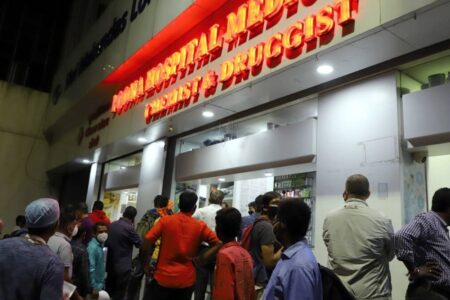Since the beginning of March, the total number of Covid patients in Nashik increased from 1.28 lakh to 2.77 lakh, at a rate higher than the state average.
Nashik District Collector Suraj Mandhare talks to Zeeshan Shaikh about how the district administration is handling the surge in cases and steps taken to ensure safety of health facilities in the district after 24 Covid-19 patients died at a hospital run by the Nashik Municipal Corporation on Wednesday as oxygen supply was disrupted due to a leakage in the main oxygen storage tank.
What steps have been taken to handle the surge in cases?
We have ramped up our testing infrastructure in the past two months. From an average of 3,000 tests per day, we have now increased our capacity to around 22,000 tests a day. In March and April so far, Nashik conducted 4.85 lakh tests. This is higher than the total tests that the district had conducted last year.
We are diligent in terms of contact tracing and ensuring that people follow the due protocols of isolation. We have opened a few school buildings in rural areas for those who don’t have proper isolation arrangements at home.
We have also mapped the hotspots and are undertaking strict perimeter control of these places by conducting rapid antigen tests at designated spots to screen potential carriers.
How have you ramped up the health infrastructure in the district? There are complaints of needy patients not getting beds and access to treatment.
We have ramped up our oxygen production from 35MT to over 95MT. This is helping us to meet today’s increased demand for oxygen.
Additionally, we have provided central oxygen lines so that more patients can get oxygen support locally. We have acquired 80 per cent utility beds from private hospitals to treat Covid patients. We are increasing the bed capacity of the Nashik civil hospital from 80 beds to 350 beds, of which, 210 beds are already operational.
We have two private medical colleges in our district and have increased the bed capacity up to 500 beds. We are also recruiting additional staff and conducting training for these resources to ensure that we can deliver top-class treatment to all patients.
Finally, our thrust is also on ensuring prophylactic treatment of residents of our district. We are ramping up our vaccine drive to cover all the age groups as per the Centre’s decision. So far, we have administered over 95 percent doses of the received vaccine.
While health infrastructure has been ramped up, there have been questions about how safe and efficient these hastily put systems are.
Your district witnessed a major accident at Dr Zakir Hussain Hospital in which 24 people died. What steps are being taken to ensure safety?
What happened last Wednesday was very unfortunate. We have ordered all government health facilities, rural as well as sub-district hospitals to undergo a fire and electrical audit. The same will be conducted in health facilities by local fire authorities. This accident underscores the need for periodic inspection for leakage and other electrical problems by concerned agencies of such mega storage tanks. An inquiry team has been set up by the government and it will come up with factual report.
Last year your jurisdiction Malegaon saw a very high fatality rate in the early stages of the pandemic. This year, though cases are increasing in other parts of the district and state, Malegaon has largely remained unaffected. What was the strategy used?
Malegaon was a huge challenge for us largely because of its population density. In the initial surge last year, inadequate facilities and late admissions of patients had led to a spike in cases and deaths. We, however, ramped up the health facilities, turning community halls and colleges into holding zones for patients. We strictly adhered to trace-test-treatment strategy. House-to-house case surveillance was done and all positive contacts were strictly isolated…
Many hospitals have complained of centralised distribution of Remdesivir by the collector’s office. What steps have been taken to make the system more transparent and efficient?
The Remdesivir problem is not about centralised or decentralised distribution but it is an issue of a huge demand and supply mismatch.
There is a huge demand for the injection but the supply is extremely inadequate. This time, the medicine is being recklessly prescribed compared to its usage in the last wave. So, we are sensitising doctors to keep the demand restricted to really deserving patients.
Centralised system mainly intends to curb long queues of people before medical shops and ensure that the limited stock is allotted to hospitals pro rata to their patient strength. Under the system, a demand is generated by the hospital along with list of patients. It is verified by medical experts and subsequently, an equitable distribution is done by the allotment desk by assigning hospital-wise quota to the distributor. Then hospitals pick up the stock from the distributor and use for the patients.
Hospitals are under obligations to preserve the empty vials and also staple the empty boxes to the IPD file of the patient for future inspection…

